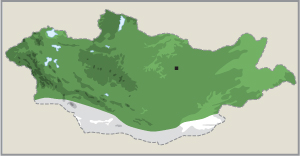
PLATE 50: PIGEONS
Common Wood Pigeon Columba palumbus
38–43 cm

ID Distinctly larger and bulkier than other Mongolian pigeons. At rest, adult shows a white patch on the side of the neck and lacks the black wing-bars of other Columba species. In flight, distinguished by prominent white bars at base of flight feathers. Voice A monotonous crooning roo-coo-coo. Habitat Forest and gardens. Behaviour Feeds mainly on ground, walking with ponderous waddling gait. Nests in trees. Status Rare and very local breeding visitor and rare passage migrant, late April to mid-September at least; some birds overwinter. Nesting is assumed but not confirmed in Tes River valley in Great Lakes Depression; may also nest near Khovd town.
Stock Dove Columba oenas
28–32 cm

ID Similar to wild-type Rock and Hill Pigeons but with slighter build, uniform dark grey upperparts, less prominent black bars on wings, and red-and-yellow bill. In flight, wing-tips and trailing edges show more extensive black, and no white rump patch. Voice On breeding grounds gives a soft uhooo calls. Habitat Forest in mountains and river valleys; also parks and gardens. Behaviour Feeds on ground. Gregarious when not breeding. Nests in tree cavities. Status Rare and very local breeding visitor and rare passage migrant, late April to early September. Nesting confirmed only in Orkhon River valley, Selenge province. Also recorded in Hentii and Khovd provinces.
Yellow-eyed Pigeon Columba eversmanni
25–31 cm

ID Similar to other Columba pigeons, especially Stock Dove, but paler than that species and with a brownish cast above; yellow eye-ring shows at close range. Voice Silent away from breeding grounds. Habitat Open country with trees. Behaviour Similar to other pigeons. Status Vagrant. Two records: one near Bulgan River, Khovd province, 1 May 1975, and one near Lake Telmen, Zavkhan province, 1 June 1998. Conservation Vulnerable globally. Listed in Threatened Birds of Asia (2001). [Alt: Pale-backed Pigeon]
Rock Dove Columba livia
30–35 cm

ID Very similar to Hill Pigeon but readily recognised, especially in flight, by absence of white tail-band. Both distinguished from other Columba pigeons in Mongolia by pale grey back and wings contrasting with darker grey head and neck. Back colour varies according to race, white in livia, pale grey in neglecta. Feral Pigeons, flocks of which are common in many cities and towns, exhibit many colour variations: white, dark blue, reddish-brown and mottled. These are descendants of birds bred in captivity and derived from both Rock and Hill Pigeons. Voice Courting male gives a three- or four-note kuku-ru-kooo; on territory, repeats a drawn-out kroooo. Habitat Wild birds nest on cliffs and in caves. Feral Pigeons in urban areas nest on buildings, bridges and other artificial structures. Behaviour Highly gregarious; nests colonially. Status Resident breeder. In Mongolia, wild Rock Doves are found on cliffs in remote areas, notably Uyench River valley in Mongol-Altai range, Bij River in Dzungariin Gobi and Ih Khyangan Mountains in far east. Feral birds occur throughout Mongolia, often in large numbers, especially in cities and towns. [Alt: Rock Pigeon]
Hill Pigeon Columba rupestris
33 cm

ID Very similar to Rock Dove, but readily distinguished, especially in flight, by broad white tail-band contrasting with blackish tip. For comparison with other Columba pigeons, see Rock Dove. Voice Higher-pitched than Rock Dove. Habitat Breeds on cliffs, in caves in remote areas and on buildings in small numbers. Feeds in open habitats, including livestock pastures. Feral birds are common in city parks. Behaviour Similar to Rock Dove. Status Common resident breeder. [Alt: Blue Hill Pigeon]